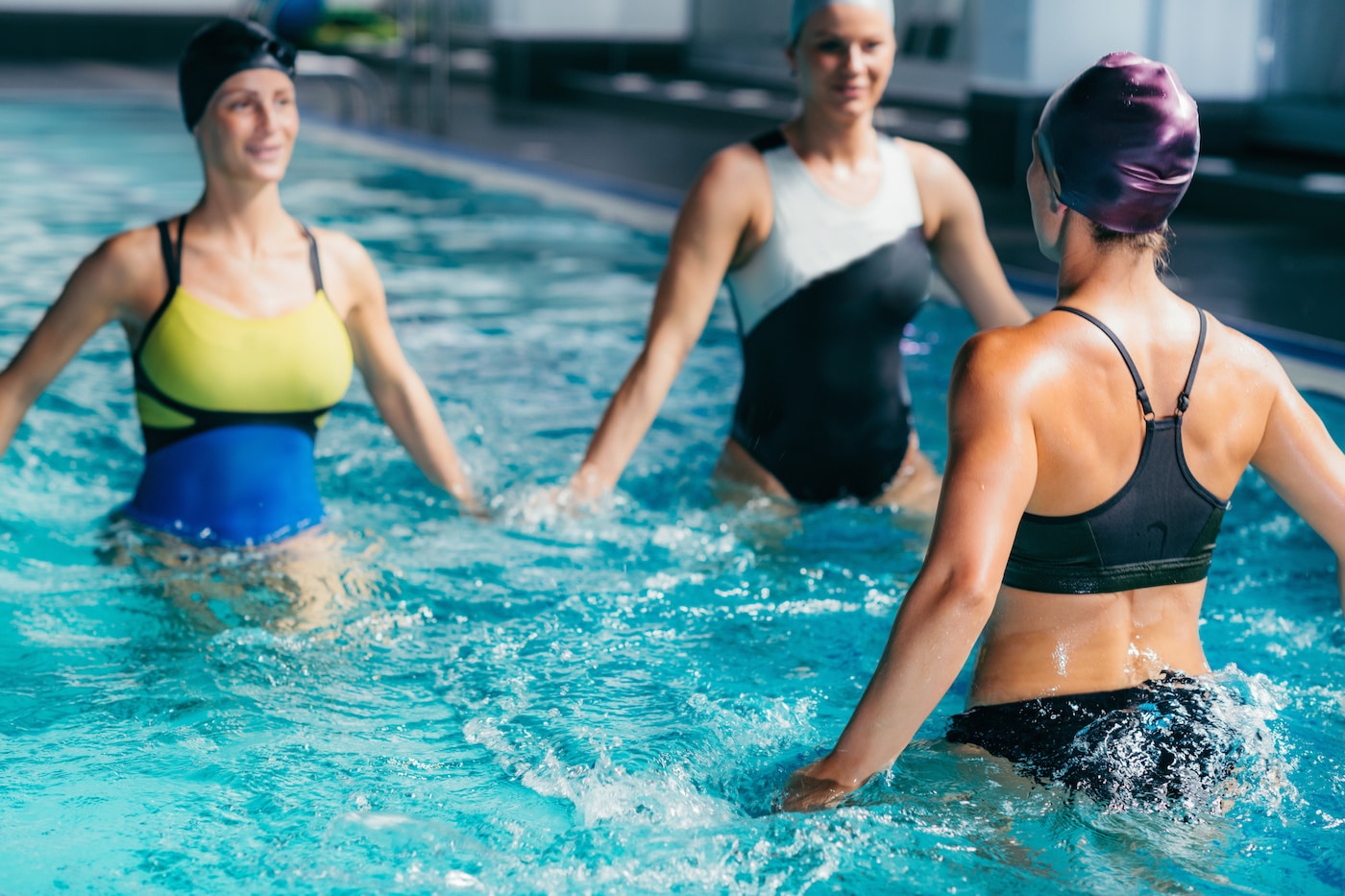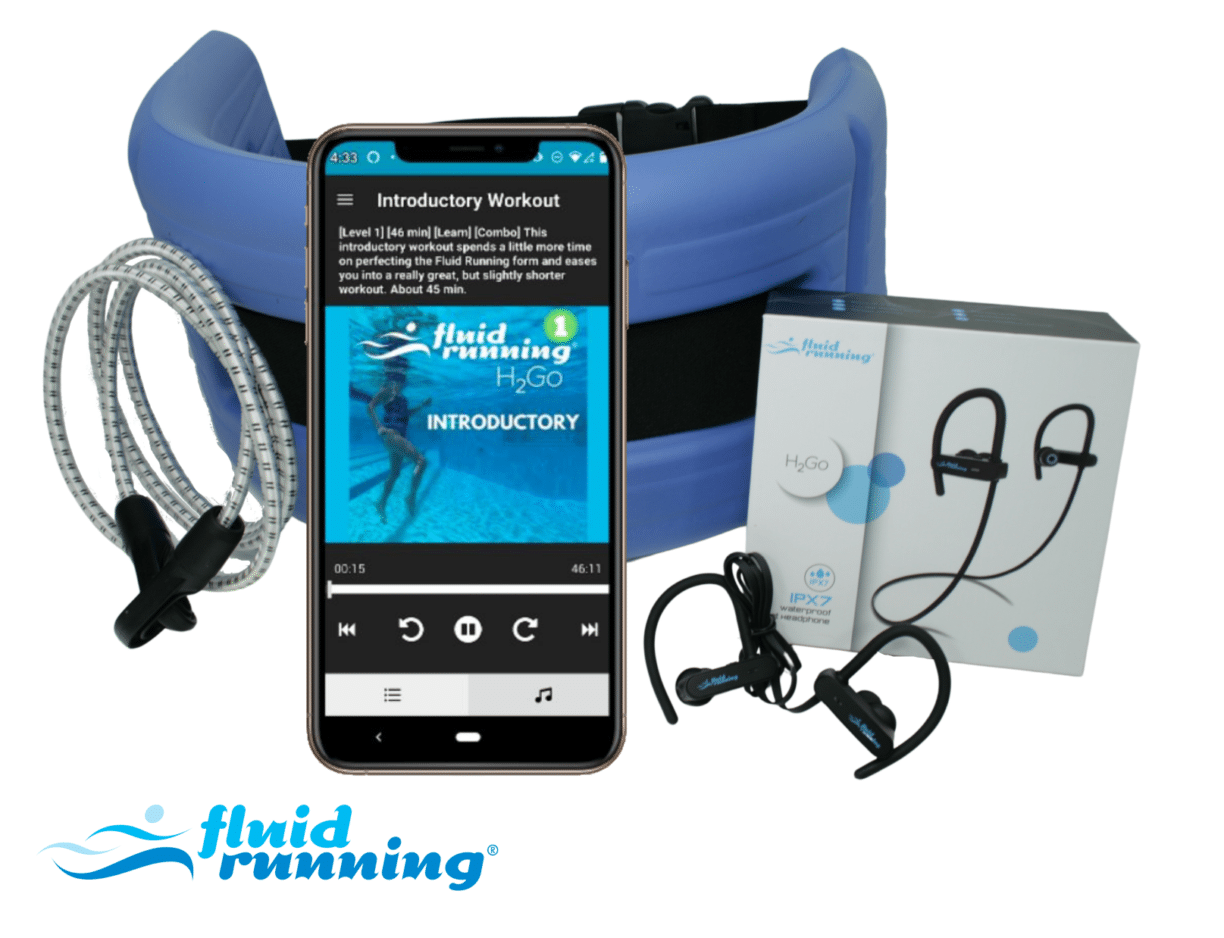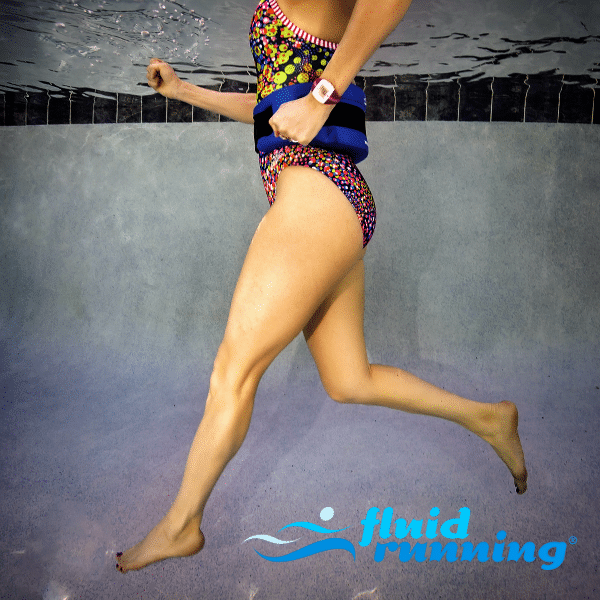Think of water aerobics and you conjure up images of grandmothers doing water aerobics in a Florida gated community and you will probably be laughing silently to yourself as they attempt to exercise “elder style.”
This is probably what you picture if someone says, “water workout.” Fluid Running is a serious aquatic high-tech workout developed by certified trainer Jennifer Conroyd after she was injured and needed to rehab to run a marathon.
The Fluid Running workout uses a flotation belt and Bluetooth, waterproof headphones that connect with the Fluid Running app in order to hear music-backed workouts, from beginner to extremely advanced, that are led by Jennifer.
Your phone stays safe and dry wrapped in a towel or gym bag. These workouts are performed in deep water such as a pool, lake, or bay. You do not travel during the workouts, the Fluid Running form keeps you in one place.
Who is a candidate for Fluid Running?
There are many reasons why and categories of people who choose to do an aquatic workout. Running in the pool is great for people who have injuries or are rehabilitating.
Pregnant women love it because it doesn’t jar or overheat the fetus. People who don’t like to sweat have no worries in the water!
If you have extra weight, there is no danger of putting additional pressure on joints since everyone is weightless in the water.
Athletes do it because they can get a full-body workout and reduce the risk of injury. For those who want to lose weight, running in deep water burns 30-40% more calories than running on land because water is 800 times denser than air.
For those looking to jumpstart an exercise program, they can go at their own pace in a beginner-level workout without the intimidation factor of a class situation.
People of all ages and fitness levels can use this program as long as they are comfortable in deep water, and you don’t need to be a runner or a swimmer.
Unlike other forms of at-home gym equipment, Fluid Running takes up virtually no space. Its components can fit in a gym bag.
How does it work?
Using a special flotation belt, you get into the deep end of the pool (or bay or lake), hit “play” on your headphones and begin one of the Fluid Running workouts.
The workouts are interval-based and combine deep water running with several other movements that keep the Fluid Runner engaged and challenged.
While serious runners have known the benefits of “water running”, many complained about a lack of mental stimulation.
Fluid Running has evolved the concept with Bluetooth, waterproof headphones, an app, and specific workouts led by founder and certified trainer Jennifer Conroyd that are geared for all fitness levels.
The water needs to be deep enough so that your feet do not touch the bottom when you are running in the upright position.
Once you receive the equipment, install the Fluid Running app, download the included workouts, and pair your new Bluetooth, waterproof headphones. All workouts are audio so there is no need to be watching a screen.
How does Fluid Running compare to running on land?
In terms of form, Fluid Running and land running form and mechanics are the same. What’s different is the impact and calorie burn. With Fluid Running, there is NO impact.
There’s no such thing as low impact running on land. Many of Fluid Running’s participants are avid runners, but running on land can cause joint stress and injuries.
Fluid Running lets people enjoy the benefits of running with none of the harmful impact. Movement in cool, circulating water helps improve flexibility while cushioning the joints and reducing inflammation.
Water also creates resistance, and uses core and upper body muscles, which is why deep water running burns about 40% more calories than land running.
What is the science behind aquatic running?
Running in deep water, combined with hydrostatic pressure enables the stimulation of metabolic and neuromuscular systems, followed by their corresponding physiological adaptations allowing both to maintain and improve athletic performance.
Aquatic exercise can also play a beneficial role in an athlete’s recovery, helping to prevent as well as treat muscle damage and soreness following exercise.
Exercising in the water can help bone density: The resistance of the water just from physical movement places a demand on the skeletal system, causing a load on the bones.
Once the bones are subjected to this stress they are forced to respond and increase muscle tension. This entire process results in stronger and denser bones. Overweight people: Aquatic exercise would seem to offer the safest and most protective environment for these individuals because of the buoyancy effects of immersion, which minimizes the risk of joint injury.
Cost: $199.00 for the complete system available for purchase on www.fluidrunning.com
Jennifer Conroyd is the founder of Fluid Running, a deep water running fitness company. Jennifer is an A.C.E. certified personal trainer, a USATF certified coach, and has an Exercise in Medicine credential from ACSM.
Jennifer is an accomplished athlete having completed the Ironman and has run 16 marathons, qualifying for the Boston Marathon 15 times.
Jennifer created Fluid Running after an injury left her unable to run in preparation for the 2010 Chicago Marathon.
She ran exclusively in deep water for the six weeks leading up to the race, and not only finished that marathon but qualified for the Boston Marathon.
Fluid Running offers group classes that Men’s Journal voted one of the Best Workouts in America.
She was named a finalist for the 2018 Women in Tech Founders award. Jennifer is a graduate of Miami University. She resides in Chicago and is the mom of three adult boys.


